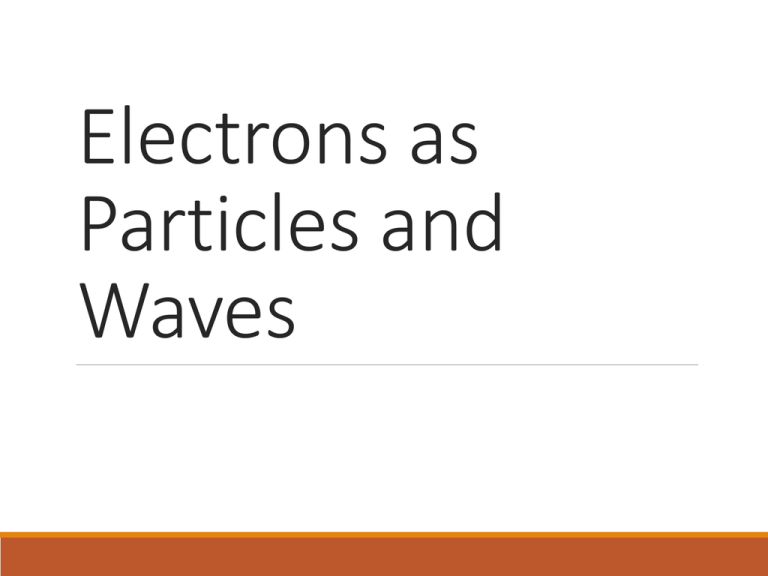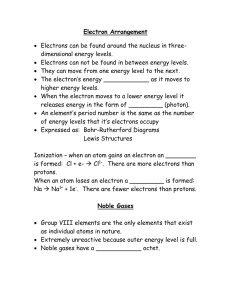Electrons as Particles and Waves
advertisement

Electrons as Particles and Waves Electrons Behave Like Particles and Like Waves It is not necessary, or useful, to say that an electron is a particle - or a wave - just that in certain circumstances it behaves like a wave, and in others like a particle wave-particle duality holds that light and matter (we’re discussing electrons) can exhibit properties of both waves and of particles If an electron behaved ONLY like a particle, it would be much easier to discuss its location and its path… Think of baseball….. Electron as a Particle Because the ball behaves like a particle, we can say that the ball will follow a well-defined path from the pitcher to the catcher Electron as a Wave If the baseball had BOTH wave and particle behaviors, the path of the baseball could not be precisely determined. The best we could do would be to make a probability map of where the baseball will cross home plate Light Waves Light Phenomenon Long wavelength ----> small frequency Short wavelength ----> high frequency Electromagnetic Spectrum Note the small area for visible light! e- normally occupy the lowest energy level that will hold it = Ground State After the e- gains energy = Excited State “Absorption” To drop down to Ground state an eloses energy as light “Emission” Similar to the electromagnetic spectrum, each element has its own specific Atomic Emission Spectrum (lines of color) like a fingerprint Atoms and Light The movement of electrons inside of atoms produces light and other electromagnetic radiation thanks to quantum mechanics. Each element gives off only certain frequencies of light, called spectral lines. In effect each element has its own signature of spectral lines allowing us to identify which element we have or what stars are made of. Helium Plancks Constant A physical constant utilized to describe the relationship between energy and frequency v = E/h h = 6.626 x 10-34 plancks constant C = λv E = Energy in Joules (m2 x kg) E = hc/λ f or v = frequency c = 3.00 x 108 m/s the speed of light E = hv Photons Max Planck in 1900 stated that the light emitted by a hot object (black body radiation) is given off. in discrete units or quanta. The higher the frequency of the light the greater the energy per quantum. Electrons as Particles Quanta: Light is energy that occurs in discrete packets Photon: Each packet of light energy is called a photon Photons behave like particles because they have the ability to move other matter (momentum). Photoelectric Effect: e- are ejected (released) from metals when light with high energy shines on them The photoelectric effect demonstrated the particle behavior of light!! Quantum Mechanic Model In the quantum-mechanical model, specific electron orbits are not appropriate: the electron's movement cannot be known that precisely. Instead, we map the probability of finding the electron at various locations outside the nucleus. The probability map is called an orbital/electron cloud. Three Rules for Writing Notations Aufbau principle - electrons enter orbitals of the lowest energy first the 7 main energy levels can have overlapping sublevels EX: that a 5 level is really higher than a 6 level Pauli exclusion principle - no two electrons can have the same 4 quantum numbers this limits the number of electrons in each orbital to 2: 1 spin up ↑, and 1 spin down ↓ Hund’s Rule - when electrons occupy orbitals of equal energy, ONE electron enters each orbital until ALL are ½ filled with electrons spinning in the same direction (all up or all down), then the orbitals are filled with the spin electrons Electron Configuration Shorthand Shorthand Notation (Noble Gas Core notation): Instead of writing the whole electron configuration notation, the symbol for the last element (noble gas) in the previous row of the periodic table, in brackets, is used for all the electrons up until that principle level or row [ ] n s Lewis Dot Structures Lewis Dots show only the electrons available for bonding, called the valence electrons. These are the electrons in the last principal quantum (energy) level. They are filled in around the element symbol starting at the top, and going around clockwise 1 on each side and continuing to 2 on each side



